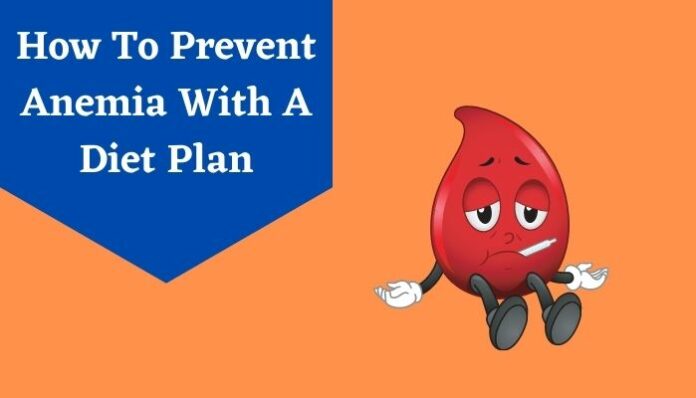Anemia is a health condition where your body doesn’t have adequate wholesome red blood cells to carry oxygen from your lungs to cells and tissues throughout your body. Though the prime reason for anemia is blood loss; the annihilation of red blood cells is another reason why your body can’t create sufficient red blood cells.
The most common type of anemia is iron-deficiency anemia. Sometimes due to the lack of folate and vitamin B-12 your body may not create red blood cells. If your body can’t create B-12 correctly, you may suffer from pernicious anemia. Thus, you should follow a proper diet plan for anemia. Your anemia diet chart must be rich in iron, B vitamins, and vitamin C.
Signs/ Symptoms of Anemia
Let’s take a look at some of the symptoms of anemia. If you are suffering from anemia, tell your doctor to check your blood levels.- Tiredness and fatigue
- Shortness of breath
- Hair thinning
- Irritability
- Shivering or feeling cold especially in your hands and feet
- Weakness
- Dizziness
- Pale skin
- Headache
Diet Plan for Anemia
By incorporating some dietary changes, you can manage your anemia. You should follow an iron rich meal plan that also contains essential vitamins to produce hemoglobin and red blood cells. You should also consume foods that help your body absorb iron better.You will get two types of iron in foods: heme iron and non-heme iron.
Heme iron is present in foods like meat, poultry, and seafood. Non-heme iron is present in plant foods and other foods that are rich in iron. Though your body can absorb both types, it absorbs heme iron more easily and quickly. The Recommended Daily Allowance (RDA) for iron is 10 milligrams (mg) for men and 12 mg for women.
To treat anemia, most people need to consume at least 150-200 mg iron daily. You may require a prescription from a doctor to purchase iron medications or any other over-the-counter iron supplements until your levels are elevated.
Also Read: A New Way Of Treatment of Anemia
Foods to Include in Anemia Diet Chart
1. Leafy Greens
Dark leafy green items like spinach, kale, collard greens, dandelion greens, Swiss chard, etc. are the perfect sources of non-heme iron. Leafy greens like Swiss chard and collard greens may also be rich in folate. The prime reason for folate deficiency anemia is the low level of folate. Citrus fruits, beans, and whole grains are also excellent sources of folate.Many green leafy items (spinach and kale) are rich in oxalates also. Oxalates may bind with iron and prevent the absorption of non-heme iron. So, green leafy items are effective in treating anemia. Vitamin C helps your stomach in absorbing iron. Consume green leafy vegetables that contain vitamin C such as oranges, red peppers, and strawberries. All these food items may enhance iron absorption. Some green leafy vegetables like collard greens and Swiss chard are excellent sources of both iron and vitamin C.
2. Meat and Poultry
All meat and poultry items are rich in heme iron. Red meat, lamb, and venison could be the perfect choices to manage your anemia. Poultry and chicken also have some amounts of heme iron.You can incorporate meat and poultry into your non-heme iron foods (leafy greens) along with vitamin C-rich fruits.
3. Seafood Items
Some seafood items are rich in heme iron. Shellfish such as oysters, clams, scallops, crabs, and shrimp are excellent sources of heme iron. Most fish are rich in iron.Fish that offer the best levels of iron include:
- Canned or fresh tuna
- Mackerel
- Mahi-mahi
- Pompano
- Fresh perch
- Fresh or canned salmon
Calcium can bind with iron and lessens its absorption. Don’t eat calcium-rich food items if you are following an iron-rich diet plan. Avoid calcium-rich food items like dairy, tofu, cheese, yogurt, plant milk, etc.
4. Fortified Foods
These days, the markets are flooded with food items that are fortified with iron. Add these foods if you are a vegetarian or don’t consume other sources of iron.- Fortified orange juice
- Fortified ready-to-eat cereals
- White bread food items
- Fortified pasta
- Foods made up of fortified cornmeal
- Fortified white rice5.
5. Beans
Beans are another excellent source of iron and they are effective for vegetarians and meat lovers also. Beans are affordable and versatile.Some iron-rich options are:
- Kidney beans
- Chickpeas
- Soybeans
- Black-eyed peas
- Pinto beans
- Black beans
- Peas
- Lima beans
6. Nuts and Seeds
Nuts and seeds are popular sources of iron. They are delicious and you can sprinkle them to decorate your salads or yogurt.Some nuts and seeds that contain iron are:
- Pumpkin seeds
- Cashews
- Pistachios
- Hemp seeds
- Pine nuts
- Sunflower seeds
Though almonds are good in iron, they are also high in calcium. So, they may not enhance your iron absorption level.
Also Read : A New Way Of Treatment of Anemia
Word of Caution
While following a specific diet plan for anemia, you must consider the below-mentioned things:- Don’t consume foods or beverages that prevent iron absorption
- Eat iron-rich foods along with vitamin C-rich foods
- Consume various heme and non-heme iron food items throughout the day
- Eat heme and non-heme iron foods together if possible
- Add foods that are high in folate and vitamin B-12




